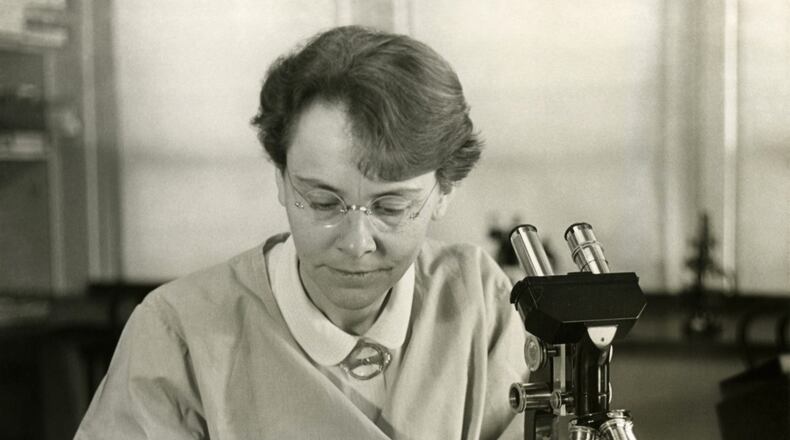As an avid, but mildly successful, gardener, I can appreciate the beautiful, rich variation in nature that is all around us – and revel at Dr. McClintock’s accomplished research to identify and describe transposable elements as the cause for the varied colors of kernels. We also appreciate the inherent difficulty of her career path and the obstacles she described that she faced as a woman. As women in medicine, a practicing clinical geneticist with board certifications in pediatrics and genetics and a practicing clinical pharmacist with board certification in pharmacotherapy, we have been fortunate to matriculate through college, medical/pharmacy school, and residency at a different time than Dr. McClintock. However, between sisters, we have confided in each other about feelings of gender inequality that still exist in medicine.
Throughout her journey in academia as a woman, Dr. McClintock was also able to navigate many challenges. After graduation and multiple fellowships, she earned a position as an assistant professor. Some sources report her male colleague “convinced” the University to offer her an assistant professorship. She was excluded from regular academic activities; she felt her promotion and tenure were dependent on her male colleague’s presence. Gender inequities were, and still are, pervasive in higher education.
In pharmacy academia, women occupy fewer professional leadership positions, have been less recognized for national achievement awards, and earn 85% of what their male counterparts earn. A proposed call to action encourages universities to address ignorance and denial while evaluating institutional structure and academic culture. One can’t help but wonder if Dr. McClintock’s departure from academia was a direct result of these same gender inequities. If given the credit she deserved earlier in life, how might her trajectory have changed?
Unfortunately, studies have identified and tracked gender differences in promotion in medical education too: women physicians faced slower promotional timelines, were less likely to reach associate or full professorship compared to males due to outdated promotion processes, and that this continues as women were less likely to be endowed chairs – even in Pediatrics – where women are the majority. Marcotte et al. describe that “too often we put the onus on women to change their behavior, but closing this gap will require institutions to make promotion systems and policies more equitable”.
Dr. McClintock was outspoken about how being a woman, and thus an outsider, allowed her to view her work with a different perspective than the men around her and make observations that they couldn’t. Likewise, our varied roles as a mother and a wife have made us better healthcare providers. Beyond direct patient care, it allows for a unique perspective in research and as the leader of a research team.
We are hopeful that Dr. McClintock would have been proud to see the progress of women in research; studies in recent years have shown that 45% of grant applicants and 38-46% of grant reviewers were women. However, that hope has been called into question: communication pauses and funding cutoffs have left patients, medical workers, researchers, and residents scared and confused about the future of health care. For example, the state of Massachusetts received approximately $4 billion in NIH and NSF funding last year with NIH funding supports more than 28,000 jobs.
Dr. McClintock’s story exemplifies why diversity in STEM research is critical, and her work exemplifies the value of basic science. Both of these concepts are very much under attack, and she is the perfect figurehead to represent this struggle. Further, think back to the mesmerizing beauty of nature in the rainbow of kernels on a colorful ear of corn. In leaving unrealized the full potential of female faculty, and not seeing the value of diversity in women physician-scientists, this would be like erasing those colors and making all corn a bland, homogenous yellow, with detriments to science, research, and medicine as a whole.
To celebrate Dr. McClintock’s birthday, on June 16, please pledge to support research and to support all researchers. Clinical geneticists, genetic counselors, physicians, pharmacists, researchers, physician-scientists, patients and the community alike must all support one another – let’s make a pledge to support science in honor of Dr. McClintock.
Check out “tiny.cc/sciencepledge” to learn about this initiative.
Dr. Stephanie Santoro is an Associate Professor of Pediatrics at Harvard Medical School, board-certified in Pediatrics and Clinical Genetics, and a practicing geneticist at Massachusetts General Hospital.
Dr. Lindsey Ferraro is an Associate Professor of Pharmacy Practice at Ohio Northern University and a board-certified pharmacist practicing at St. Rita’s Medical Center.
Dr. Stephanie Santoro and Dr. Lindsey Ferraro were both born in Cincinnati, OH, grew up in Fairfield, OH graduated from Fairfield High School and then attended the University of Cincinnati for undergrad (followed by the UC College of Medicine for Dr. Santoro and UC College of Pharmacy for Dr. Ferraro). Their parents also attended Fairfield High School and then Miami University.

